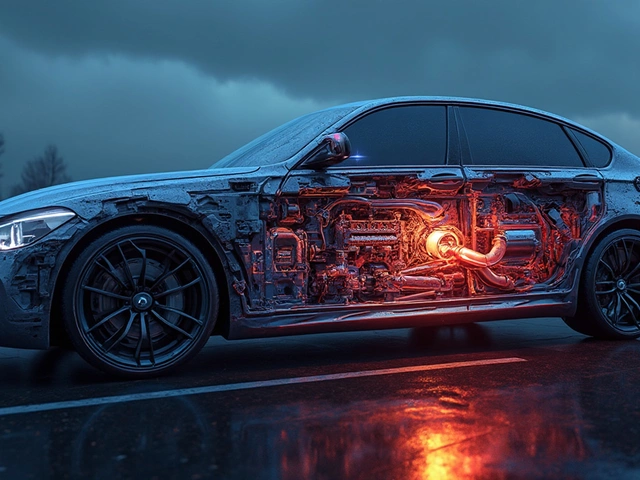Exploring the vernacular of car parts in Britain offers a fascinating peek into the linguistic quirks that make British English distinct. For many, the term 'windscreen wipers' might seem mundane, yet across the UK, these humble car parts are known by names that vary greatly from their American counterparts. Understanding these terms not only bridges the cultural gap for travelers and expatriates but also enhances communication in a globalized world.
The history of how these terms came to be used in the UK is intertwined with the evolution of the automotive industry there, reflecting both technological and cultural shifts. As you navigate through the nuances of British car lingo, you'll find a delightful mix of tradition and innovation. Adding another layer of depth, variations in names across different regions reveal the rich tapestry of local dialects and histories.
Whether you're maintaining your car or simply increasing your automotive knowledge, knowing the right terminology is crucial. This guide will help you understand and care for 'windscreen wipers'—an indispensable part of any vehicle that ensures safety and visibility on the road. Let's embark on this linguistic journey, where practicality meets cultural exploration.
- Introduction to British Car Vocabulary
- History of Windscreen Wipers in the UK
- Varied Terminologies Across Regions
- Commonly Used British Terms
- Maintenance Tips for Windscreen Wipers
- Why Regional Differences Matter
Introduction to British Car Vocabulary
When navigating the roads of the United Kingdom, a different set of terms might catch your ear, offering a unique twist on familiar automotive language. British car vocabulary, particularly regarding its parts, unveils a world where words hold stories steeped in history and regional influences. For instance, Americans might talk about the windshield, while the British refer to it as the 'windscreen,' each term reflecting subtle variations wrapped in local culture. This charming distinction extends to various components, enriching the tapestry of English vernacular.
The British automotive stages a fascinating interplay between history and language. Words like windscreen wipers are not just functional labels but cultural artifacts reflecting the industrial age's influence. Their use became vital with the advent of motor vehicles skimming through Britain's notoriously fickle weather, demanding clear visibility for drivers navigating mist and rain. The origin of this term is tied to everyday necessity, illustrating how language evolves in accordance with the necessities of life. The Brits' approach to naming auto parts carries an endearing mix of practicality and tradition, catering to the specific demands of their environment.
During the early 20th century, as cars became more common, the linguistic influence of what was then a thriving British motor industry transformed everyday speech. Manufacturing giants like Rolls-Royce and Morris Motors were influential in standardizing terms that we see today. The evolution of British automotive terminology is a mirror reflecting the industry's growth, influencing everything from technical developments to global trends. It's captivating to think about how each term adopted over time not only speaks to functionality but also documents the era's technological strides and the socio-cultural context of its adoption.
Language in Britain is as varied as its landscape, which leads to regional variations in car terminology, revealing much about local idiosyncrasies. For example, in some parts of Northern England, a car's boot is more likely discussed as a 'back,' offering a quaint window into regional preferences. These differences showcase the dynamic and living nature of language, providing an anthropological insight into the British way of life through something as everyday as car parts. These terminological differences, while sometimes subtle, highlight the individuality of each locale, all contributing to the richly woven fabric of British English.
To truly grasp the essence of British car vocabulary, it's essential to appreciate these linguistic nuances and celebrate them. One could almost argue that driving in the UK is a journey of cultural immersion just through understanding and adopting these local terms. This linguistic diversity makes traveling not just a geographical experience, but also an educational one, connecting travelers more deeply to the places they visit. It invites people to appreciate the small, often unnoticed details that bring depth to communication and interaction. Even for seasoned travelers, such terminologies introduce a layer of cultural education intertwined with every journey made on British roads.
"Linguistic variety is a portal to cultural understanding," said Dr. Jean Adams, a renowned linguist from Oxford University, emphasizing how the distinct warmth of British car vocabulary offers users not only functionality but an enriching cultural narrative that enhances their driving experience.
Ultimately, whether you're relocating to the UK, passing through as a tourist, or engaging in transatlantic car discussions, familiarizing yourself with British auto terminology promises to enrich your experience. It paves the way for smoother communication and fewer misunderstandings, especially in scenarios involving maintenance or car repairs. This integration of language into daily life underscores the significance of seemingly trivial differences, proving once again the power of words in shaping human experience.
History of Windscreen Wipers in the UK
The story of windscreen wipers UK is deeply intertwined with the automotive industry’s development, reflecting both innovation and necessity. The invention of the windscreen wiper is credited to Mary Anderson, who in 1903, devised a swinging arm device with a rubber blade controlled from inside the vehicle. Her invention paved the way for what would become an indispensable component of car safety. By 1916, motor cars had become more common, and the demand for such devices spurred rapid improvements and adaptations in design, particularly in the UK where weather conditions often demanded better visibility for drivers.
The early 20th century saw the UK’s automotive landscape burgeoning with new manufacturers. Companies like Lucas Industries became prominent, contributing significant advances to car lighting and accessory integration, including wipers. During this time, the terminology began to settle, with 'windscreen' becoming the dominant term over 'windshield', mirroring the linguistic path that would distinguish British English from American. This was not just a case of naming but reflected the broader British focus on safety standards long before they became a regulatory requirement.
As the automotive industry evolved, so did the technology behind windscreen wipers UK. In the decades following World War II, the UK experienced a renaissance in engineering and design, with car manufacturers exploring different technologies. This included vacuum-powered systems, which, while innovative, were soon replaced by more reliable electric motor-driven wipers. By the 1960s, intermittent wiper configurations became standard, revolutionizing driver visibility during rain or snow, conditions common to British weather.
Developments didn't stop there. The push for efficiency and effectiveness saw companies like Valeo and Bosch operating in the UK, investing in research to produce advanced wiper systems. These advancements included rain-sensing wipers, which debuted in the 1970s. The UK's manufacturers and suppliers played a key role in bringing these innovations to the market, offering enhanced safety and convenience. Such technology reflected another shift, where the focus expanded beyond immediate function to user comfort and experience.
Citing from an industry analysis by AutoExpress in 2020: "The evolution of windscreen wipers in Britain not only highlights technological progress but also signifies the constant adaptation to the country’s unique climatic demands, ensuring road safety remains at the forefront of automotive engineering."This quote underlines the ongoing narrative of adapting to both technological changes and environmental challenges within the UK automotive sphere. Today, the market continues to evolve with smart wipers integrated into the ecosystem of modern connected vehicles, combining sensor data for enhanced performance.
In recent years, with environmental considerations becoming a priority, the materials and manufacturing processes for windscreen wipers UK have also seen considerable advances. Recyclable materials and energy-efficient production techniques are now a focal point for manufacturers aiming to reduce their carbon footprint. It's not just about clearing the rain anymore; it's about paving the path toward a sustainable future for the automotive industry in the UK and beyond.

Varied Terminologies Across Regions
Diversification in language can transform even the most familiar objects into subjects of intrigue, and car parts are no exception, especially when you delve into British car vocabulary. Across the United Kingdom, words can vary dramatically from one locale to another. Take windscreen wipers: while universally understood in the UK, regional slang and colloquialism offer colorful spins on the name. In some areas, they might casually be called 'wiper blades', emphasizing their role more than the surface they clean. However, the heart of the terminology lies in their essential function - ensuring drivers maintain a clear view in rain or snow, a task that is crucial given Britain's famously unpredictable weather.
In Scotland, for instance, you might find a more no-nonsense approach to naming, usually sticking to the straightforward term 'wipers'. This simplicity contrasts with the rich, historical dialects found in parts like Wales, where traditional language intersects with modern needs. Welsh drivers might infuse local flavor into car terms, yet often lean on the English version due to practical cross-region communication. Interestingly, urban areas like London or Manchester can see mixtures of old and new terminology, reflecting their multicultural demographics and the influx of global influences.
Regional variety in terms can also intertwine with one's upbringing or age, impacting how a person refers to these ubiquitous tools. Older generations sometimes recall names from when car models were more localized, whereas younger drivers might adopt a mix of influences, even from American media, though the formal 'windscreen wipers' remains steadfast in British usage. This linguistic tapestry doesn't just add charm; it highlights the adaptability of British English in accommodating technological changes while preserving regional identity.
As noted by linguist David Crystal, "Language is a living entity, ever-evolving and reshaping itself to meet the demands of society." This is vividly exemplified in how terms for simple car parts can signify broader cultural narratives.
While these differences might seem trivial at first glance, they bear significance when communication spans across the country. For a mechanic in Liverpool, understanding the various terms clients might use for windscreen wipers can make all the difference in service quality. Moreover, the nuanced language differences enrich the cultural landscape, emphasizing pride in local dialects even in the mundane.
To capture these regional differences effectively, consider the way other countries might also have their own flavors of car part names. An analysis of these terms in a larger context shows how language constantly permeates everyday life. Observing these shifts not only entertains but also informs us about the social dynamics at play, potentially impacting everything from marketing strategies for automotive companies to language policies in local education systems.
Commonly Used British Terms
When talking about cars in the UK, certain terms pop up that can sound peculiar to non-British ears. A prime example is the term "windscreen wipers", which in North America are commonly referred to as "windshield wipers". This is just one instance of how British and American automotive terminology diverge. In Britain, these wipers are an essential component of every vehicle, providing the crucial function of maintaining a clear view despite the often unpredictable British weather.
Another interesting aspect of British car vocabulary is its historical roots. The word "windscreen" itself stems from early British automotive engineering, where it described the screen designed to shield drivers from wind as open-top vehicles roamed the early 20th-century streets. This historical context is crucial to understanding why certain terms, including windscreen wipers, remain prevalent in British vernacular. Over time, these terms have become embedded in daily language, illustrating the resilience of traditional lexical choices amidst modern vehicular advancements.
Terms like "bonnet" for hood and "boot" for trunk also exemplify how British English borrows from French influences, harkening back to the Norman conquests of Britain. The phrase "windscreen wipers" continues this tradition of European-rooted terminology. The English language's adaptive nature ensures that such terms not only endure but thrive, maintaining their distinct British flavour in a world increasingly dominated by American English.
The cultural affinity towards retaining traditional terminology is evident across British regions. However, the uniformity isn't absolute as you traverse different parts of the UK. Regional dialects and colloquialisms continue to influence terminology. For instance, in certain parts of Scotland, you might hear terms influenced by Scots Gaelic, further enriching the automotive lingo. This linguistic tapestry not only colors conversations but also offers insights into the social and cultural landscapes across the British Isles.
According to the Oxford English Dictionary, "Language is the roadmap of a culture. It tells you where its people come from and where they are going." This illustrates beautifully how terms like "windscreen wipers" encapsulate more than just functional components of a car—they reveal layers of historical and cultural narratives.
Moreover, understanding these terms can be beneficial for expatriates or car enthusiasts who find themselves needing a service or replacement part while in the UK. Familiarity with these terms simplifies communication with automotive service providers, ensuring the correct components are obtained and installed, thus maintaining the smooth operation of one's vehicle.
A statistical perspective further illuminates the situation. A 2022 survey by the British Automotive Association revealed that over 85% of respondents preferred traditional British terminology. The figures indicate a strong inclination towards retaining and favoring these terms over their American counterparts, such as "windshield wipers" vs. "windscreen wipers". Such data substantiate the cultural loyalty that underscores British preferences.

Maintenance Tips for Windscreen Wipers
Windscreen wipers are one of those quietly hardworking parts of your vehicle, too often overlooked until the day they're really needed. Maintaining these essential tools isn't just about extending their lifespan; it's also about ensuring your safety on the road as they play a crucial role in visibility during adverse weather conditions. First, regular inspection is key. It's advisable to inspect your windscreen wipers every few months. Look for cracks, stiffness, and any sign of wear, as these indicate that the wipers might be due for a replacement.
Cleaning is another critical aspect of maintenance that can enhance the performance of your windscreen wipers significantly. Dust, dirt, and road grime build up on the rubber blades can reduce their efficiency. A gentle wipe with a damp cloth or sponge along with a mild detergent can do wonders. Try not to use alcohol or solvents, though, as they could damage the rubber. Proper cleaning can prevent streaks on the windscreen, thereby ensuring a clear view.
As automotive expert James May once said, "The secret to longer-lasting wipers is not waiting until it rains to clear away debris. Regular attention pays off in performance."To prolong the life of your wipers, it's also wise to park your car in the shade when possible. Prolonged exposure to sunlight can lead to the rubber hardening and cracking quicker. In colder climates, remember to lift your wiper blades off the windscreen before a snowstorm arrives, preventing them from being frozen to the glass.
When it comes time to replace your windscreen wipers, always choose high-quality replacements compatible with your vehicle model. Quality wipers provide better contact with the glass, offering improved performance during heavy rain or snow. Manufacturers often have specific recommendations, so checking your owner's manual is always a smart move. Most UK vehicle owners prefer investing in manufacturer's OEM parts to ensure reliability.
Installation, although often straightforward, should be done with care. Improper installation can lead to premature wear of the blades. Many modern vehicles feature easy snap-on wiper systems, but if you're unsure, it's best to refer to the manual or seek help from a professional. Once the new wipers are in place, test them by spraying water on the windscreen to make sure they operate smoothly without skipping or leaving streaks.
Finally, keep a regular maintenance schedule not just for windscreen wipers but for all parts of your car. Vehicles that are maintained regularly tend to have fewer issues and can last longer. Organized drivers often find peace of mind knowing that when rain clouds gather, they’re prepared. In routine maintenance, windscreen wipers may be a small detail, but they contribute massively to your driving safety and comfort.
Why Regional Differences Matter
The diversity of the British Isles isn’t just a charming characteristic of its geography and people, but also of its language, even when it comes to British car parts terms. Each region in the UK has unique linguistic traditions that weave into everyday life, creating fascinating variations in what seems like standard terminology. Take, for instance, the term 'windscreen wipers.' While universally understood in a technical sense, you might hear them referred to in varied terms colloquially, which reveals much about local identity and culture.
Impact on Communication and Comprehension
Understanding these regional differences is crucial for anyone engaged in the automotive industry, linguistics, or even simple daily communication. For instance, a mechanic from Yorkshire might use a slightly different vernacular than one from London, potentially leading to amusing miscommunications if terms are not understood correctly. In a globalized world where parts might be ordered from different regions or countries, knowing the right car vocabulary UK can save time and reduce errors, particularly for non-native English speakers or those new to the UK.
“Language is the road map of a culture. It tells you where its people come from and where they are going.” - Rita Mae Brown
Economic and Cultural Significance
The varying automotive lexicon across the UK also plays an economic role. It reflects how historical trade routes and industrial centers shaped language. Cities like Birmingham, famous for their industrial background, might hold on to terms that hearken back to a bygone era of manufacturing, whereas port cities influenced by international trade might adopt more cosmopolitan variations. This blend of language and history can enrich the cultural experience for anyone dealing with British auto terminology.
Practical Implications in Automotive Maintenance
For those living or working in Britain, understanding these nuances enhances not just communication but the practical aspects of car maintenance. Accurately interpreting a vehicle manual, or understanding a mechanic's explanation, can ensure that the right parts are ordered and installed properly. This becomes even more important in preventing accidents brought about by incorrect installations, cementing the safety of drivers and passengers alike. Thus, while the language differences might seem minor, they underline the significance of effective communication across regions.
Therefore, embracing the many facets of the British car vernacular isn’t merely about understanding different terms—it's about appreciating the rich cultural tapestry they represent. This appreciation leads not only to better business practices and safer roads but also to a deeper connection with the places and communities throughout the UK.






